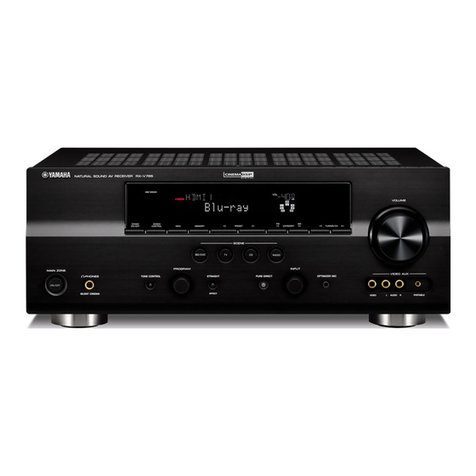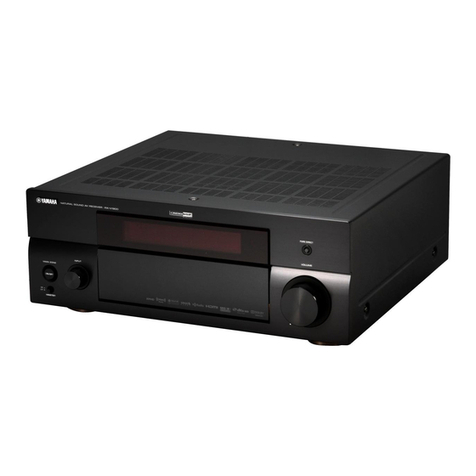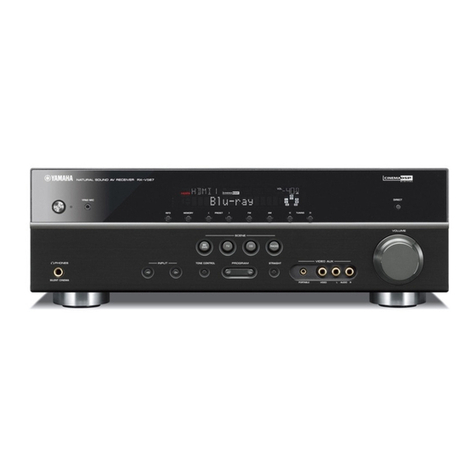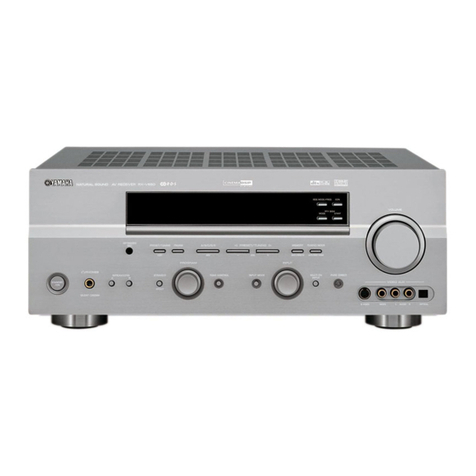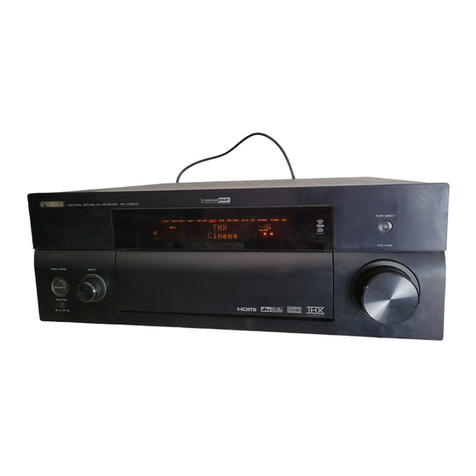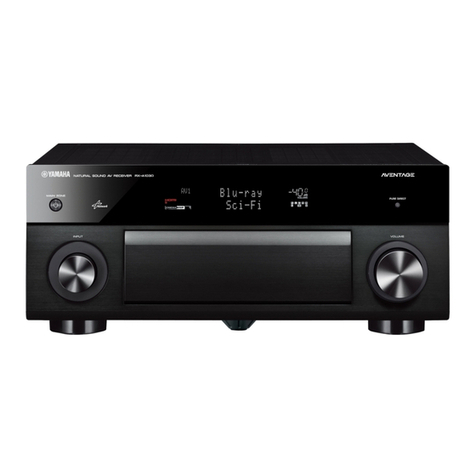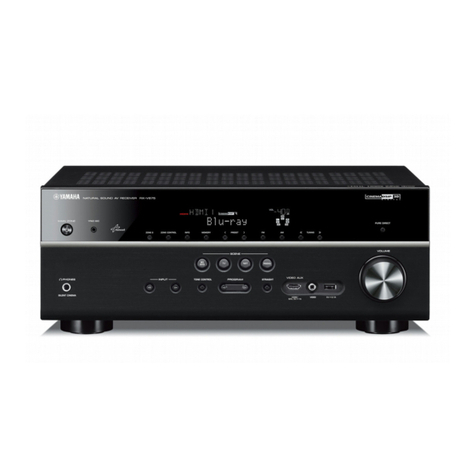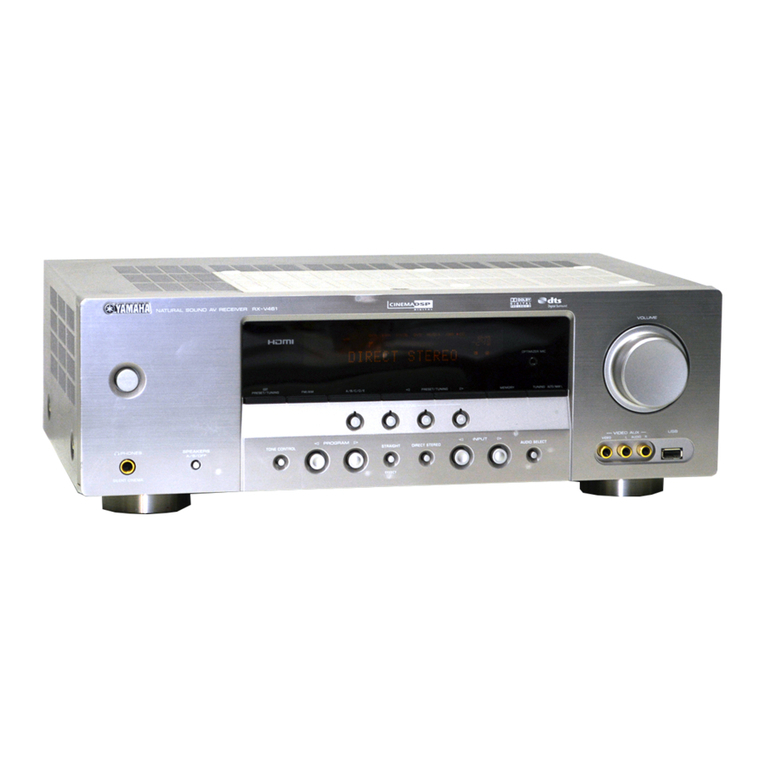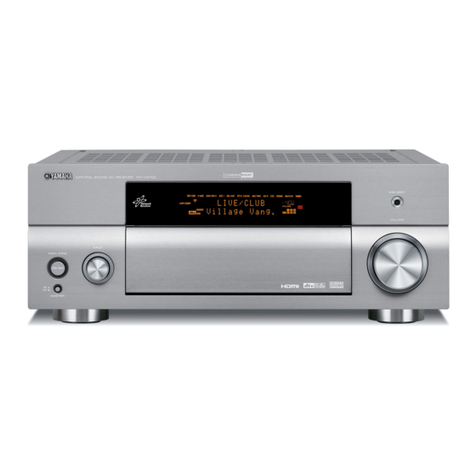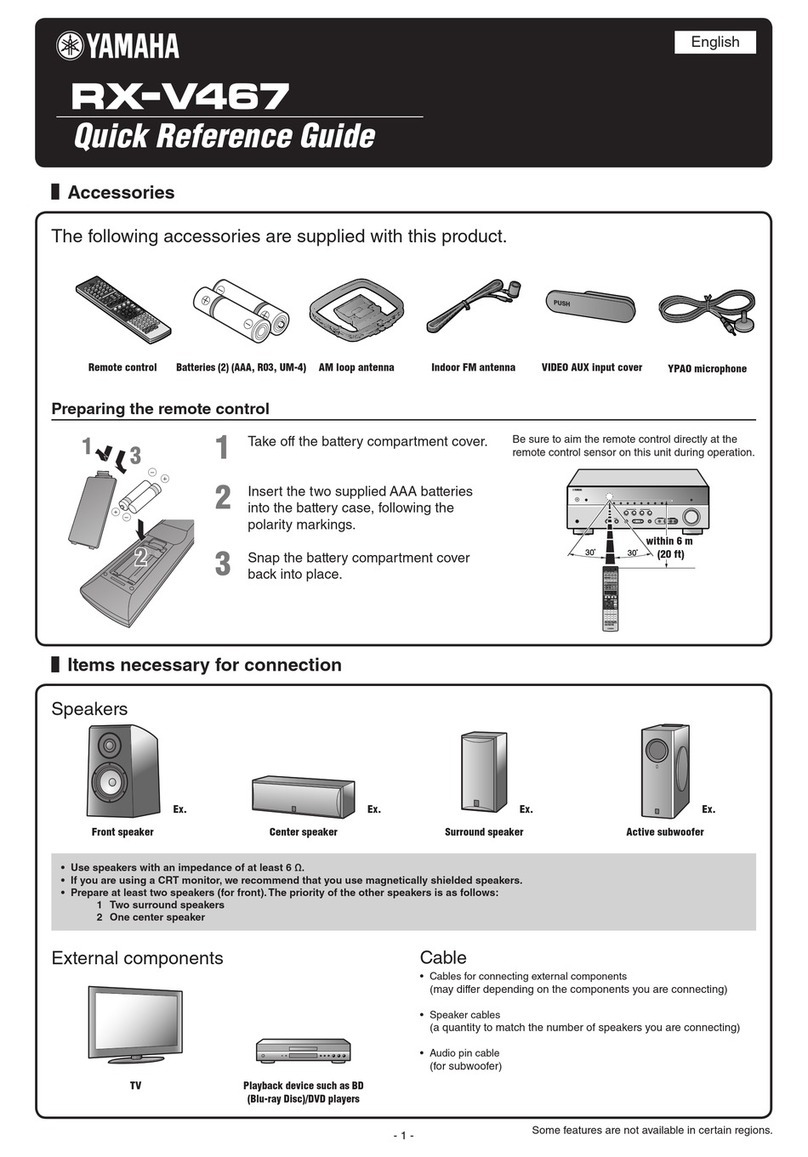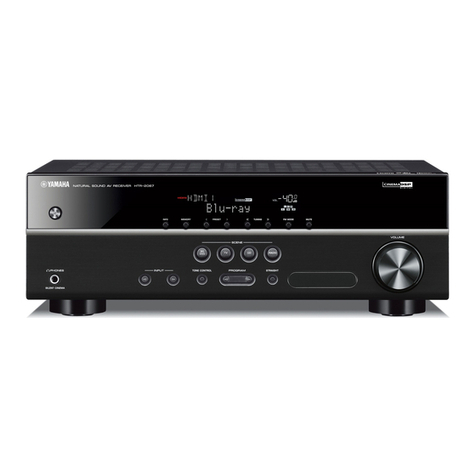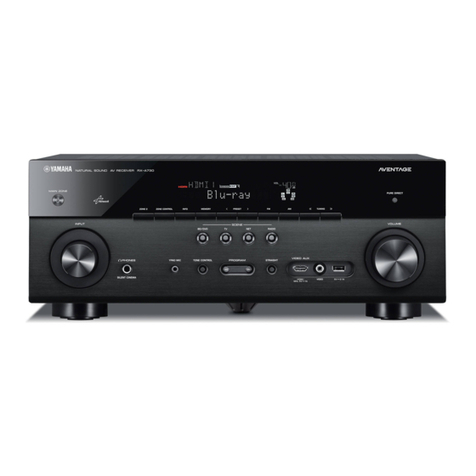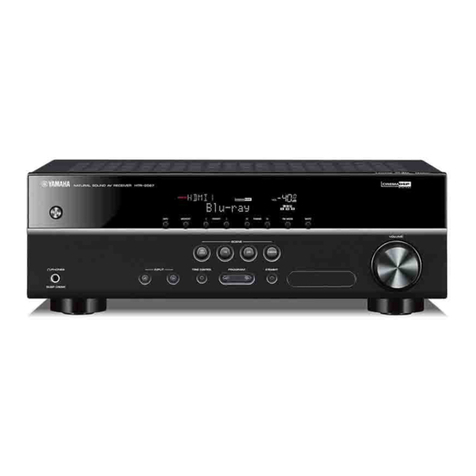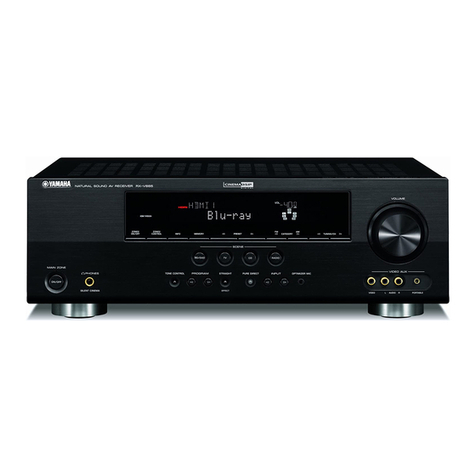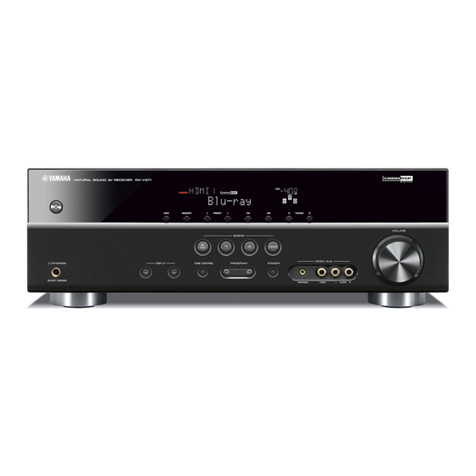
CAUTION: TO REDUCE THE RISK OF
ELECTRIC SHOCK, DO NOT REMOVE
COVER (OR BACK). NO USER-SERVICEABLE
PARTS INSIDE. REFER SERVICING TO
QUALIFIED SERVICE PERSONNEL.
.
Explanation of Graphical Symbols
A
The
lightningflashwitharrowheadsymbol.
withinancquilatemltriangle,isintendedtoaicrt
youtothepresenceof uninsulated“dangerous
voltage”withintheproduct‘senclosurethatmay
beof sufficientmagnitudetoconstituteitrisk01
electricshocktopersons.
A
Theexclamationpointwithinanoquilatcrnl
triangleisintendedtoalertyoutothepresenceof
importantoperatingandmaintenance(servicing)
mstructionsintheliteratureaccompanyingthe
/2\ applhnce.
WARNING
TO REDUCE THE RISK OF FIRE OR ELECTRIC SHOCK,
DO NOT EXPOSE THIS UNIT TO RAIN OR MOISTURE.
ReadInstructions -All the safety andoperating instructions
should be readbefore the product is operated.
Retain Instructions -The safety andoperating instructions
shouldbe retainedfor future reference.
HeedWarninga- All warnings on the product and in the
operating instructions should be adheredto.
Follow Instructions -All operating and useinstructions
shouldbe followed.
Cleaning - Unplug this product from the wall outlet before
cleaning. Do not useliquid cleanersor aerosolcleaners.
Use adamp cloth for cleaning.
Attachments - Do not useattachmentsnot recommended
by theproduct manufacturerasthey may causehazards.
Waterand Moisture - Do not usethis product nearwater -
for exatnple, nearabath tub, washbowl, kitchen sink. or
laundry tub; in awet basement;or neara swimming pool;
andthe like.
Accessories- Do not placethis product on an unstablecart,
stand,tripod, bracket, or table. The product may fall,
causingseriousinjury to a child or adult, and serious
damageto the product. Use only with acart, stand,tripod,
bracket,or table recommendedby the lnanuf@urer, or sold
with the product.Any mounting of the product should
follow the manufacturer’s instructions, and should usea
mounting accessoryrecommendedby the manufrrcturer.
A product andcart combination should be
moved with care.Quick stops,excessive
force, and unevensurfacesmay causethe
product andcart combination to overturn.
10
11
12
13
14
15
16
17
18
19
Ventilation - Slots andopeningsin the cabinet areprovided
for ventilation andto ensurereliable operation of the
product andto protect it from overheating,andthese
openingsmust not be blocked or covered.The openings
shouldneverbe blocked by placing theproduct on a bed,
sofa,rug, or other similar surface.This product should not
beplaced in a built-in installation suchasa bookcaseor
rack unlessproper ventilation is provided or the
manufacturer’s instructions havebeenadheredto.
Power Sources-This product should beoperatedonly from
the type of power sourceindicated on the marking label. If
you arenot sureof the type of power supply to your home,
consult your product dealeror local power company.For
products intendedto operatefrom battery power. or other .
sources,refer to the operating instructions.
Grounding or Polarization - This product may beequipped
with apolarized alternating current line plug (aplug having
onebladewider thanthe other).This plug will fit into the
power outlet only oneway. This is asafety feature. If you
areunableto insert the plug fully into theoutlet, try
reversing the plug. If theplug should still fail to fit, contact
your electrician to replaceyour obsoleteoutlet. Do not
defeatthe safety purposeof the polarized plug.
Power-Cord Protection - Power-supplycords should be
routed so that they arenot likely to be walked on or pinched
by items placedupon or againstthem,paying particular
attention to cords atplugs, conveniencereceptacles,andthe
point where they exit from the product.
Lightning - For addedprotection for this product during a
lightning storm, or when it is left unattendedandunusedfor
long periods of time. unplug it from the wall outlet and
disconnectthe antennaor cable system.This will prevent
damageto the product due to lightning and power-line
surges.
Power Lines -An outside antennasystemshould not be
locatedin the vicinity of overheadpower lines or other
electric light or power circuits, or where it canfall into such
power lines or circuits. When installing an outsideantenna
system,extreme careshouldbetaken to keepfrom touching
suchpower lines or circuits ascontact with them might be
fatal.
Overloading - Do not overload wall outlets, extension
cords,or integral conveniencereceptaclesasthis canresult
in arisk of fire or electric shock.
Object andLiquid Entry - Never pushobjects of any kind
into this product through openingsasthey may touch
dangerousvoltage points or short-out partsthat could result
in atire or electric shock.Never spill liquid of any kind on
the product.
Servicing - Do not attempt to servicethis product yourself
asopening or removing covers tnay exposeyou to
dangerousvoltage or other hasards.Refer all servicing to
qualified servicepersonnel.
DamageRequiring Service- Unplug this product from the
wall outlet andrefer servicing to qualified service personnel
underthe following conditions:
a) When the power-supply cord or plug is damaged.
b) If liquid hasbeenspilled, or objects havefallen into
the product,
c) If the product hasbeenexposedto rain or water,
I CAUTION
SAFETY
INSTRUCTIONS
Explanation of Graphical
Symbols
WARNING
TO REDUCE
THE
RISK
OF
FIRE
OR
ELECTRIC SHOCK,
DO NOT EXPOSE THIS UNIT TO RAIN OR MOISTURE.
Ventilation -Slots and openings
in
the cabinet are provided
for ventilation and to ensure reliable operation
of
the
product and to protect it from overheating, and these
openings must not be blocked or covered. The openings
should never be blocked by placing the product on abed,
sofa, rug,
or
other similar surface. This product should not
be placed
in
abuilt-in installation such as abookcase
or
rack unless proper ventilation
is
provided
or
the
manufacturer's instructions have been adhered to.
Power Sources -This product should
be
operated only from
the type
of
power source indicated on the marking label.
If
you are not sure
of
the type
of
power supply to your home,
consult your product dealer or local power company. For
products intended to operate from battery power, or other
sources, refer to the operating instructions.
Grounding
or
Polarization -This product may be equipped
with apolarized alternating current line plug (a plug having
one blade wider than the other). This plug will fit into the
power outlet only one way. This
is
asafety feature. Ifyou
are unable to insert the plug fully into the outlet, try
reversing the plug.
If
the plug should still fail to fit, contact
your electrician to replace your obsolete outlet. Do not
defeat the safety purpose
of
the polarized plug.
Power-Cord Protection -Power-supply cords should be
routed so that they are not likely to be walked on or pinched
by
items placed upon
or
against them, paying particular
attention to cords
at
plugs, convenience receptacles, and the
point where they exit from the product.
Lightning -For added protection for this product during a
lightning storm, or when
it
is left unattended and unused for
long periods
of
time, unplug
it
from the wall outlet and
disconnect the antenna or cable system. This will prevent
damage to the product due to lightning and power-line
surges.
Power Lines -An outside antenna system should not be
located
in
the vicinity
of
overhead power lines
or
other
electric light or power circuits,
or
where it
can
fall into such
power lines or circuits. When installing
an
outside antenna
system, extreme care should be taken to keep from touching
such power lines or circuits as contact with them might be
fatal.
Overloading -Do not overload wall outlets, extension
cords, or integral convenience receptacles as this can result
in
arisk
of
fire or electric shock.
Object and Liquid Entry -Never push objects
of
any kind
into this product through openings as they may touch
dangerous voltage points or short-out parts that could result
in
atire
or
electric shock. Never spill liquid
of
any kind on
the product.
Servicing -Do not attempt to service this product yourself
as opening
or
removing covers may expose you to
dangerous voltage or other hazards. Refer all servicing to
qualified service personnel.
Damage Requiring Service -Unplug this product from the
wall outlet and refer servicing to qualified service personnel
under the following conditions:
a)
When the power-supply cord
or
plug is damaged,
b) If liquid has been spilled, or objects have fallen into
the product,
c)
If
the product has been exposed to rain
or
water,
11
17
10
12
18
16
15
14
13
19
The lightning flash with arrowhead symbol.
within
an
eyuilateml triangle,
is
intended to
alc11
you to the presence
of
uninsulated "dangerous
voltage" within the product's enclosure that may
be
of
sullicient magnitude
to
constitute arisk
of
electric shock to persons.
The exclamation point within an equilateral
triangle
is
intended to alert you to the presence
of
important operating and maintenance (servicing)
instructions
in
the literature (lceompanying the
appliance.
CAUTION: TO REDUCE THE RISK
OF
ELECTRIC SHOCK,
DO
NOT REMOVE
COVER (OR BACK). NO USER-SERVICEABLE
PARTS INSIDE. REFER SERVICING TO
QUALIFIED SERVICE PERSONNEL.
Read Instructions -All the safety and operating instructions
should be read before the product
is
operated.
Retain Instructions -The safety and operating instructions
should be retained for future reference.
Heed Warnings -All warnings on the product and
in
the
operating instructions should be adhered to.
Follow Instructions -All operating and use instructions
should be followed.
Cleaning -Unplug this product from the wall outlet before
cleaning. Do not use liquid cleaners or aerosol cleaners.
Use adamp cloth for cleaning.
Attachments -Do not use attachments not recommended
by the product manufacturer as they may cause hazards.
Water and Moisture -Do not use this product near water -
for example, near abath tub, wash bowl, kitchen sink,
or
laundry tub; in awet basement;
or
near aswimming pool;
and the like.
Accessories -Do not place this product on an unstable cart,
stand, tripod, bracket, or table. The product may fall,
causing serious injury to achild
or
adult, and serious
damage to the product. Use only with acart, stand, tripod,
bracket, or table recommended by the manufacturer, or sold
with the product. Any mounting
of
the product should
follow the manufacturer's instructions, and should use a
mounting accessory recommended
by
the manufacturer.
Aproduct and cart combination should
be
I)
moved with care. Quick stops, excessive
force, and uneven surfaces may cause the h.
product and cart combination to overturn.
~
2
4
7
9
3
5
6
8
I
CAUTION
SAFETY
INSTRUCTIONS
Explanation of Graphical
Symbols
WARNING
TO REDUCE
THE
RISK
OF
FIRE
OR
ELECTRIC SHOCK,
DO NOT EXPOSE THIS UNIT TO RAIN OR MOISTURE.
Ventilation -Slots and openings
in
the cabinet are provided
for ventilation and to ensure reliable operation
of
the
product and to protect it from overheating, and these
openings must not be blocked or covered. The openings
should never be blocked by placing the product on abed,
sofa, rug,
or
other similar surface. This product should not
be placed
in
abuilt-in installation such as abookcase
or
rack unless proper ventilation
is
provided
or
the
manufacturer's instructions have been adhered to.
Power Sources -This product should
be
operated only from
the type
of
power source indicated on the marking label.
If
you are not sure
of
the type
of
power supply to your home,
consult your product dealer or local power company. For
products intended to operate from battery power, or other
sources, refer to the operating instructions.
Grounding
or
Polarization -This product may be equipped
with apolarized alternating current line plug (a plug having
one blade wider than the other). This plug will fit into the
power outlet only one way. This
is
asafety feature. Ifyou
are unable to insert the plug fully into the outlet, try
reversing the plug.
If
the plug should still fail to fit, contact
your electrician to replace your obsolete outlet. Do not
defeat the safety purpose
of
the polarized plug.
Power-Cord Protection -Power-supply cords should be
routed so that they are not likely to be walked on or pinched
by
items placed upon
or
against them, paying particular
attention to cords
at
plugs, convenience receptacles, and the
point where they exit from the product.
Lightning -For added protection for this product during a
lightning storm, or when
it
is left unattended and unused for
long periods
of
time, unplug
it
from the wall outlet and
disconnect the antenna or cable system. This will prevent
damage to the product due to lightning and power-line
surges.
Power Lines -An outside antenna system should not be
located
in
the vicinity
of
overhead power lines
or
other
electric light or power circuits,
or
where it
can
fall into such
power lines or circuits. When installing
an
outside antenna
system, extreme care should be taken to keep from touching
such power lines or circuits as contact with them might be
fatal.
Overloading -Do not overload wall outlets, extension
cords, or integral convenience receptacles as this can result
in
arisk
of
fire or electric shock.
Object and Liquid Entry -Never push objects
of
any kind
into this product through openings as they may touch
dangerous voltage points or short-out parts that could result
in
atire
or
electric shock. Never spill liquid
of
any kind on
the product.
Servicing -Do not attempt to service this product yourself
as opening
or
removing covers may expose you to
dangerous voltage or other hazards. Refer all servicing to
qualified service personnel.
Damage Requiring Service -Unplug this product from the
wall outlet and refer servicing to qualified service personnel
under the following conditions:
a)
When the power-supply cord
or
plug is damaged,
b) If liquid has been spilled, or objects have fallen into
the product,
c)
If
the product has been exposed to rain
or
water,
11
17
10
12
18
16
15
14
13
19
The lightning flash with arrowhead symbol.
within
an
eyuilateml triangle,
is
intended to
alc11
you to the presence
of
uninsulated "dangerous
voltage" within the product's enclosure that may
be
of
sullicient magnitude
to
constitute arisk
of
electric shock to persons.
The exclamation point within an equilateral
triangle
is
intended to alert you to the presence
of
important operating and maintenance (servicing)
instructions
in
the literature (lceompanying the
appliance.
CAUTION: TO REDUCE THE RISK
OF
ELECTRIC SHOCK,
DO
NOT REMOVE
COVER (OR BACK). NO USER-SERVICEABLE
PARTS INSIDE. REFER SERVICING TO
QUALIFIED SERVICE PERSONNEL.
Read Instructions -All the safety and operating instructions
should be read before the product
is
operated.
Retain Instructions -The safety and operating instructions
should be retained for future reference.
Heed Warnings -All warnings on the product and
in
the
operating instructions should be adhered to.
Follow Instructions -All operating and use instructions
should be followed.
Cleaning -Unplug this product from the wall outlet before
cleaning. Do not use liquid cleaners or aerosol cleaners.
Use adamp cloth for cleaning.
Attachments -Do not use attachments not recommended
by the product manufacturer as they may cause hazards.
Water and Moisture -Do not use this product near water -
for example, near abath tub, wash bowl, kitchen sink,
or
laundry tub; in awet basement;
or
near aswimming pool;
and the like.
Accessories -Do not place this product on an unstable cart,
stand, tripod, bracket, or table. The product may fall,
causing serious injury to achild
or
adult, and serious
damage to the product. Use only with acart, stand, tripod,
bracket, or table recommended by the manufacturer, or sold
with the product. Any mounting
of
the product should
follow the manufacturer's instructions, and should use a
mounting accessory recommended
by
the manufacturer.
Aproduct and cart combination should
be
I)
moved with care. Quick stops, excessive
force, and uneven surfaces may cause the h.
product and cart combination to overturn.
~
2
4
7
9
3
5
6
8
I
CAUTION

